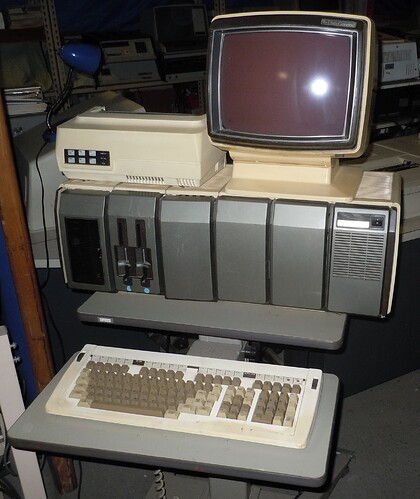I had never heard of this, and I’ve been an avid reader of Apple lore since the mid-90s. Crazy. Thought some on here would appreciate it.
I love the concept, but agree with the article that it would probably have been prohibitively unwieldy in practice. Looking at the images and renders with a dozen or more modules, I can see a fully tricked-out Jonathan taking over an entire office! Still, a neat idea that clearly led to some of the things we got later.
Thanks. Great article.
Although such a concept would’ve been a nightmare to design and build in the 80’s, the concept could be built today with off-the-shelf parts, thanks to standard high-speed bus technologies like USB and Thunderbolt.
Data General tried a similar concept in the early '80s (picture courtesy ricomputermuseum.org)
Having worked at DG at the time. the concept sounded good in theory. In practice it was a not-so-great, unwieldly implementation. Way too much space taken up for what you got.
From right to left… (not left-to-right as initially posted), this particular implementation has:
- Power supply
- CPU ( this is a Model 10 that had a 16-bit DG microECLIPSE and an 8086 co-processor that would allow you to sort-of run MS-DOS compatible software).
- I/O expansion (proprietary slots)
- Hard drive (some form of “winchester” hard disk technology)
- Twin 5 ¼ Floppy
- Cartridge tape (I believe it was QIC).
Thank you. A very interesting read indeed. Personally, I was intrigued by the bits about the Big Mac. It would be a long time until something better than the 68000 would ship in a classic Mac case. But when it finally did, it was the stunningly awesome SE/30. ![]()
New to me as well but a design strategy that has I am sure has a few other outings.
The general idea was simple, but in practice, this machine would have been a nightmare. The backbone of the system would need to accept modules from Apple and other companies, letting users build what they needed in terms of functionality
That seems a strange concern from the company that had successfully managed the open Apple // bus architecture, which was one of its selling points.
Then Sculley delivered the coup de grâce — voicing the fear that once the Mac and DOS were offered on the same platform, more Mac users might move to DOS then DOS users would move to the Mac.
Maybe not users, but certainly developers: when OS/2 was supposed to be “a better DOS than DOS, and a better Windows than Windows”, software companies preferred to put out Windows versions of their offerings, rather than native OS/2 versions, since those would run quite well on OS/2.
It is that time of year.
Love the dead silence.
Nothing like a good rickrolling to quiet things down.
Shouldn’t that read “From-right to-left…”? The two modules on the left look like Cartridge & Floppy respectively to me, while the far right module seems to have a power button on its top right corner.
Yes it should. Too fast with the keys and not enough brain.
I’ve edited the post… Thanks!
